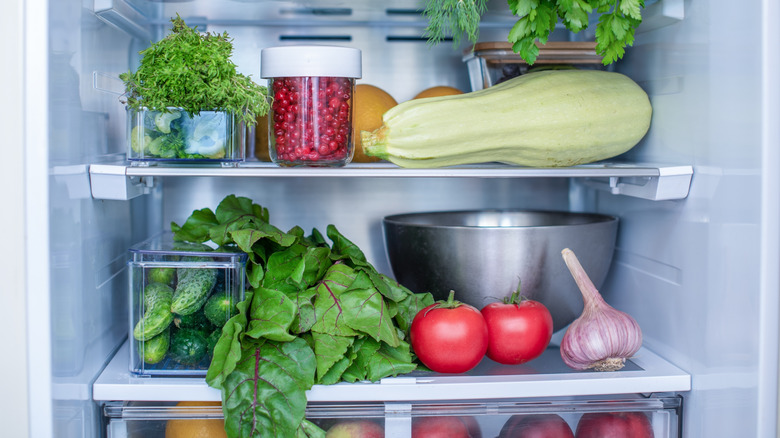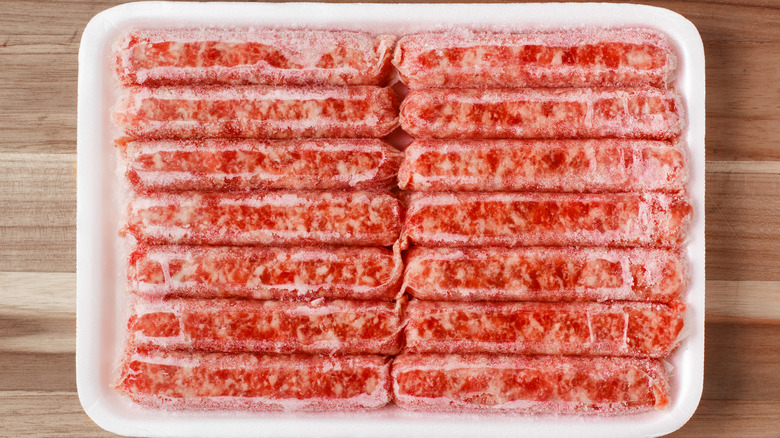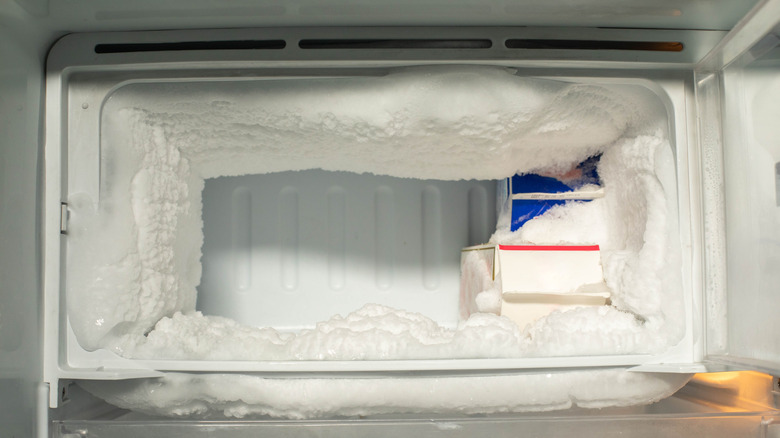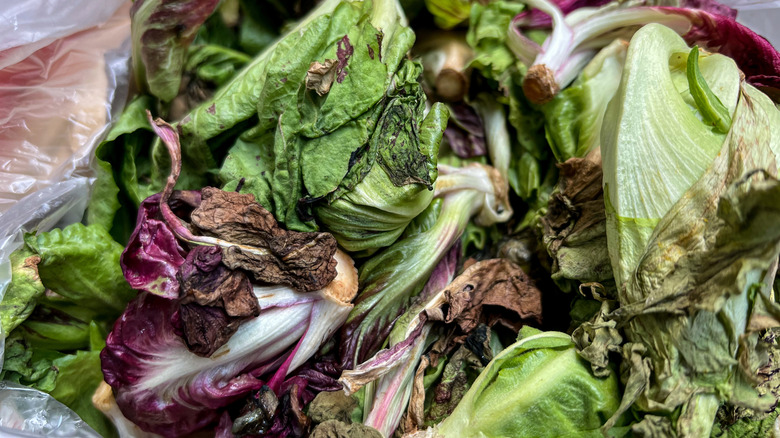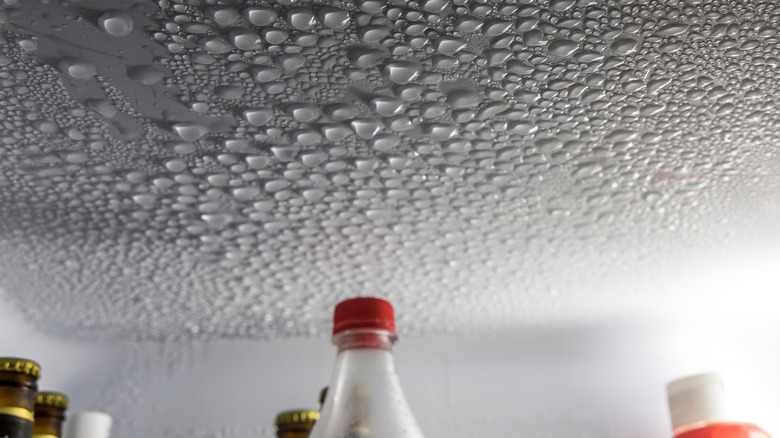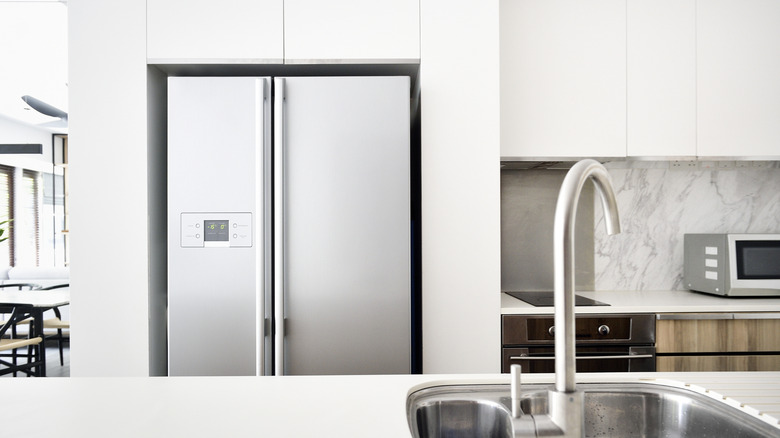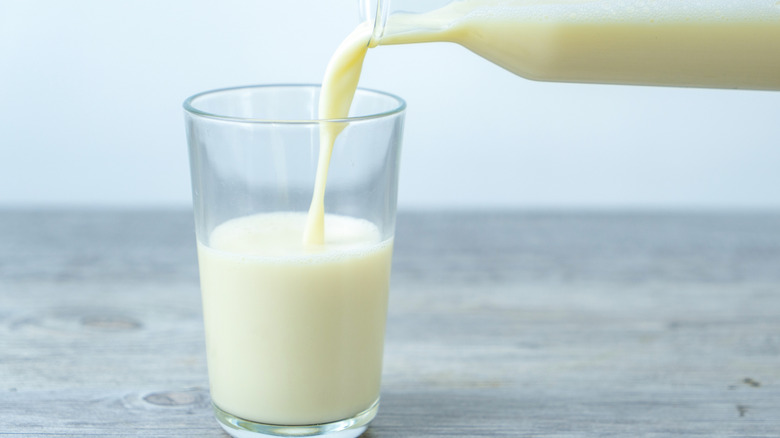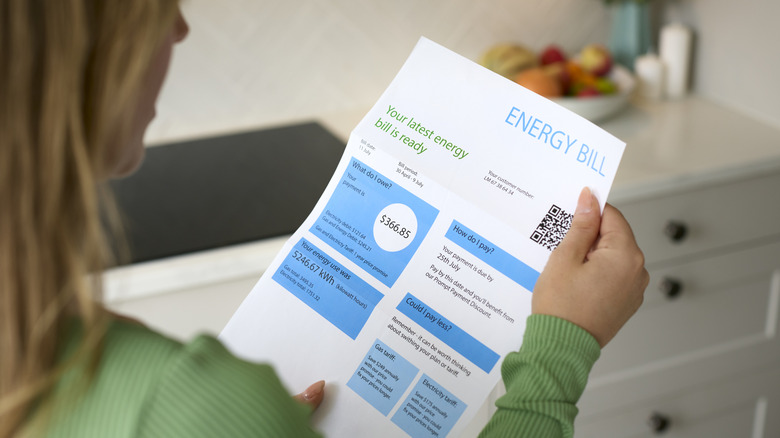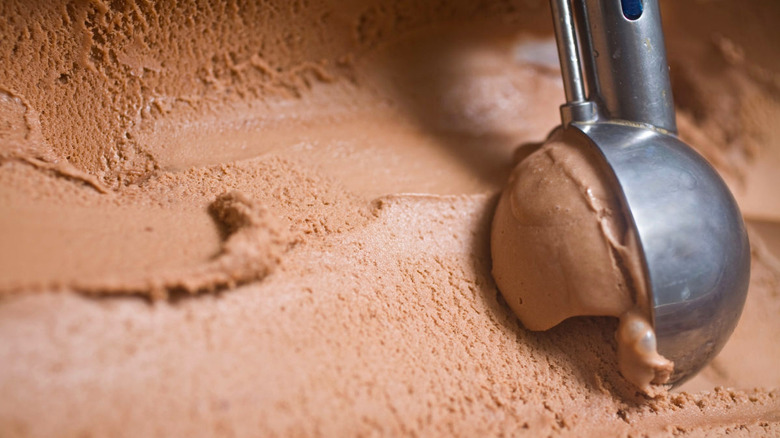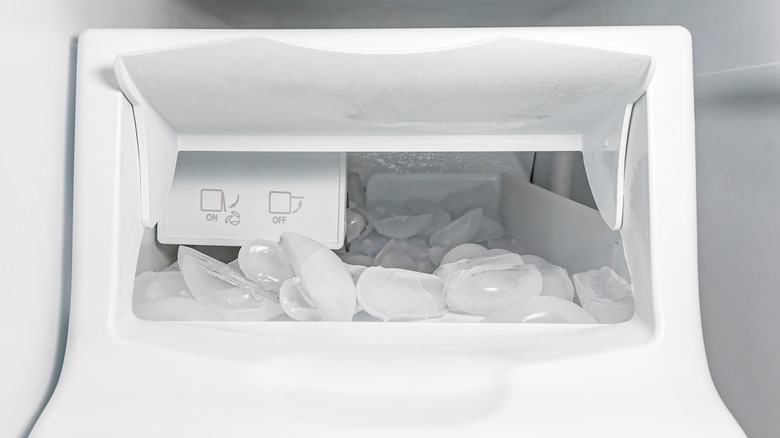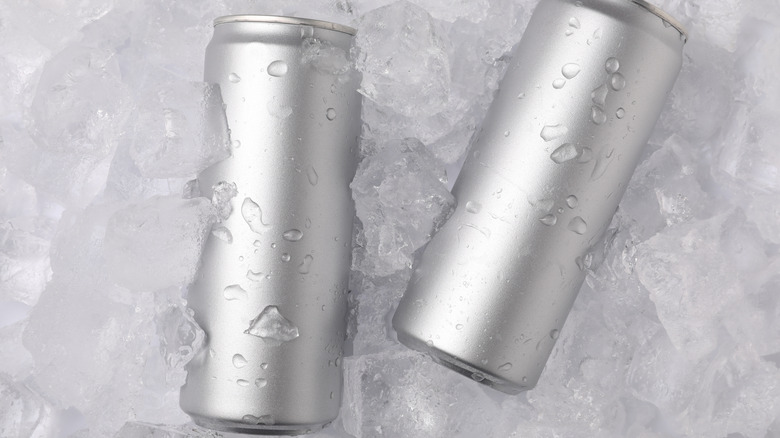11 Signs Your Fridge Or Freezer Is Way Too Cold
Appliances can be deceptively low-maintenance. Take your refrigerator, for example. It's easy to assume it's quietly doing its job in the background, on autopilot. And, to be fair, it usually is. But when something's off, it can quickly turn into a real headache. While many fridge-related concerns are tied to ensuring the interior is cold enough to keep your food fresh and safe, the opposite issue can be just as problematic. A fridge or freezer that's too cold might seem harmless (isn't colder better?), but if your appliance dips below the recommended range, it can lead to a number of problems. Over-chilling can compromise the quality and shelf life of your food, put extra strain on your appliance's performance over time, and drive up your energy bill.
The ideal temperature for a refrigerator lies between 33 and 40 degrees Fahrenheit, with experts agreeing that 37 degrees Fahrenheit hits the sweet spot. Your freezer, meanwhile, should be set at or below zero degrees Fahrenheit. Some models have settings that dip as low as minus 10 degrees Fahrenheit, but colder isn't always better.
The easiest way to check your fridge and freezer temperatures is by using an appliance thermometer. Still, it's one of those things that's easy to forget about. Luckily, your fridge, freezer, and food usually offer some pretty clear clues when they're running too cold. In this article, we'll walk you through the most common signs to look out for — so you can keep your food (and your wallet) in good shape.
Your produce, eggs, and drinks are freezing
Ever gone to crack an egg, only for it to be rock solid, or worse, half frozen, gooey slush? Or poured a glass of milk and discovered the spout clogged up with flakes of ice? These are classic signs your fridge is too cold. While 33 degrees Fahrenheit sits at the lower edge of the safe refrigeration range, it's just one degree above freezing. Anything lower than that is enough to wreak havoc on high-moisture foods.
When fruits, veggies, or eggs start freezing, the impact is more than just an inconvenience — it's a quality killer. Produce that's iced over can turn mushy or rubbery, losing its natural texture and flavor. Eggs are especially vulnerable. It can be hard to tell if the eggs inside your fridge are still good, and freezing them can cause the shells to crack and the yolks to congeal into a thick, syrupy consistency that's less than appetizing.
The coldest part of a fridge is usually the bottom shelf and the back of the unit. These areas are more prone to cold spots than others. The most common culprit? Blocked air vents. When these are obstructed, the airflow becomes uneven. Food sitting directly in front may freeze, while the rest of the fridge struggles to stay properly chilled.
You're getting freezer burn
Freezer burn is more than just an eyesore – it's a clear indicator that something is off. It happens through a process called sublimation, where water in food goes from a solid (ice) to a gas (vapor) without passing through a liquid state. In the case of freezer burn, moisture escapes from the food and re-freezes on its surface, forming the familiar layer of frosty buildup.
While freezer-burned food is still safe to eat, the texture, taste, and appearance will be dramatically compromised. Things like meat and veggies become tough and rubbery or shriveled, while ice cream will lose its smoothness, instead developing a grainy, gritty consistency from the ice crystals.
Freezer burn is typically the result of poor storage practices and inconsistent temperatures. If containers aren't sealed tightly or your food is wrapped loosely, the cold, dry air can easily penetrate, and moisture leaches out. But even when everything is packaged up properly, a freezer that runs too cold can speed up the process. When your freezer runs below the recommended zero degrees Fahrenheit, the air inside gets even drier, and the more quickly water molecules can escape from the food and into the air, intensifying the drying effect. To avoid freezer burn, ensure your freezer maintains a stable temperature, use airtight containers, and avoid overcrowding so air can flow freely. Your food — and taste buds — will thank you.
Ice or frost builds up on the walls
If you're starting to notice frost or ice buildup on the interior surfaces or walls of your freezer, it's easy to blame excessive humidity or the door being left open. But there's another explanation — your freezer may be running too cold. When the freezer temperature dips below the ideal zero degrees Fahrenheit mark, it can accelerate ice formation, especially if there's any moisture already in the air. Another issue is hot foods being placed in the freezer without cooling off first, giving off steam that freezes over. Over time, the layer of frost can spread over air vents or temperature sensors, throwing off the appliance's internal regulation system, and potentially creating a cycle of over-cooling.
Many modern freezers are equipped with an auto-defrost cycle, during which a small heater turns on temporarily to melt any minor accumulated ice or frost. This can also be disrupted if temperature fluctuations or excessive coldness are taking place. Once the ice has accumulated, it can be tricky to get rid of. It's not only unsightly, but it also encroaches on valuable storage space and impairs your freezer's performance. To rectify the issue, it may be necessary to reset your freezer by defrosting it completely. It's a hassle, but sometimes the only way to truly reset the cycle. A good rule of thumb: Stick to zero degrees Fahrenheit, and resist the urge to crank it lower.
Your greens are wilting or turning brown quickly
There's a reason your refrigerator has a crisper drawer: It's specifically designed to help fruits and vegetables last longer. These compartments maintain a slightly warmer temperature and higher humidity level than the rest of your refrigerator, making them ideal for storing delicate produce that requires more moisture to keep fresh. Leafy greens like lettuce, spinach, and kale fare best between 35 and 40 degrees Fahrenheit. When kept in colder temperatures, these items can suffer from freezing injuries or chilling injuries– damage that occurs when cold air exposure interrupts normal metabolic functioning and destroys plant cell structures. The result is salad greens that brown quickly, are wilted, and coated with a slimy texture.
A freezing injury renders your produce unappetizing and unsafe. And chilling injuries create an internal environment ripe for disease, bacterial growth, and fungal infections, all of which accelerate spoilage and lead to food waste. Using the crisper drawer and maintaining proper fridge temperature helps prevent this by slowing dehydration and protecting produce from the harshest, coldest spots in the fridge. For maximum freshness, make sure to keep your fruits and veggies in their proper place. A little attention to storage conditions and temperature settings can go a long way in preserving the texture, taste, and safety of your produce, reducing both food and monetary waste.
Condensation is building on the fridge walls
Spotting a few water droplets inside your fridge isn't always a bad thing, and it's no cause for panic. A small amount of condensation in your fridge is actually totally normal. It happens when the moisture in the cold air condenses on the interior walls, especially after opening the door or adding new groceries. However, an excess of condensation, like the accumulation of pools of water forming on shelves or beads dripping down the walls, is usually not a good sign. Common causes include a worn or faulty door gasket that lets warm air sneak in, high humidity levels in your fridge, or overcrowding that blocks air circulation.
The temperature setting is another major factor. If your fridge is set too cold, the compressor may run longer than necessary, giving water less time to drain and leading to a damp, sweaty environment inside. While it may seem like a non-issue, this can come alongside issues like mold growth, causing food to spoil faster, and even lead to long-term damage to the appliance. Keep an eye on specific areas of your fridge — excess condensation will often appear on the back wall, which tends to be the coldest area. To avoid this, make sure your refrigerator is set to the correct temperature, is sealed off tightly, and is not over-packed. A little maintenance goes a long way.
Your fridge is running really loudly
Fridges are supposed to make a little noise. The soft hum from the kitchen is a subtle reassurance that everything is working as it should, keeping your food fresh and cool. But if you're regularly hearing a loud, angry buzzing that doesn't seem to shut off, it's probably a good idea to investigate. One common cause is an overactive compressor, often triggered by a fridge that's set too cold. Refrigerators rely on a continuous compression cycle to pressurize and circulate refrigerant, maintaining the ideal internal temperature. When the thermostat is set below the recommended level, the compressor has to work hard and run longer than necessary. The extra effort creates louder, more prolonged noises, and even worse, can shorten the lifespan of your appliance.
Another key player is the condenser fan, which helps remove heat produced by the condenser coils and compressor. When your compressor is working overtime, so is the fan, which could lead to wearing on the motor or blades. It can also manifest as a screeching, vibrating, or loud buzzing sound that is anything but pleasant. The fix is simple – stop making your fridge work so hard by keeping it at the right temperature. You'll help your compressor last longer, avoid unnecessary repairs, and enjoy the peaceful sound of a healthy appliance.
Your milk or dairy is turning slushy
Sometimes, all you want is a glass of ice-cold milk — but not so cold that it actually turns to ice. Dairy is especially sensitive to temperature, and storing it properly is the key to maintaining freshness. The back part of the fridge, where it's colder, is ideal, but if your fridge is set too low, milk can start to freeze. Unlike water, milk has a lower freezing point (around 31 degrees Fahrenheit) since it contains things like lactose and minerals. So if you're pouring a slushy mess or finding icy shards in your milk, your fridge is definitely too cold.
For best results, the recommended temperature for your fridge is 33 to 40 degrees Fahrenheit, which keeps dairy safely chilled without damaging its texture or flavor. When milk freezes, the fat can separate and destabilize, leaving it with a grainy texture or uneven consistency. While it's still safe to drink, the mouthfeel and taste will suffer. The same thing goes for other dairy products like yogurt, sour cream, cream cheese, and the like. Freezing can cause them to become watery, lumpy, or otherwise unappetizing. To avoid ruining your favorite dairy staples, double-check your fridge settings, and keep an eye out for those telltale ice crystals next time you pour a glass.
Your energy bill is higher than usual
Nobody likes wasting money, especially on something as avoidable as an overachieving refrigerator. Yet, if your fridge is running colder than necessary, that's exactly what might be happening. Temperature guidelines exist not just to protect your food, but also to ensure that your appliance is operating efficiently and minimizing carbon emissions. An overly cold setting can quietly drive up your energy consumption and, in turn, inflate your utility bill. It might not look like a dramatic spike overnight, but those extra dollars can add up over time. But the good news is that there's an easy fix if you know where to look.
First and foremost, it's important to note that not all areas of your fridge maintain the same temperature. Cold air sinks and warm air rises, meaning the top and bottom shelves tend to run warmer and colder than the middle, respectively. That's why experts suggest placing a glass of water right in the center shelf and letting it sit undisturbed for a few hours with a fridge thermometer in. Then, simply check the reading to see your unit's average internal temperature. From there, you'll have a clear indication as to which direction the settings need to go. So, take a minute to check your settings. It's a small step that could shave a few dollars off your energy bill, reduce your carbon footprint, and help your fridge perform at its best.
Rock-solid ice cream
Keeping ice cream frozen is crucial. But few things are more frustrating than getting an urgent hankering for ice cream, digging through the freezer, and discovering your pint rock-hard and impossible to scoop. Even at standard freezer temperatures, most ice creams need a few minutes on the counter to soften before serving, or better yet, a warm scoop prepped by soaking in hot water. But if your freezer is set too cold, the wait time only gets longer. That leaves you with two less-than-ideal options — either patiently wait it out, or resort to a desperate and uneven microwave thaw.
But the inconvenience goes beyond a delayed treat. When stored below minus 4 degrees Fahrenheit, ice cream begins to lose the very qualities that make it so satisfying. Its smooth, creamy texture gives way to grittiness, and delicate flavors can start to dull. Excessively cold freezers also dry out the air inside, which accelerates freezer burn. As moisture escapes from the ice cream and refreezes on the surface, ice crystals form that ultimately ruin the consistency. To keep your scoops soft, flavorful, and dreamy, it's important to store your ice cream properly. This means sealing containers tightly to block out air and keeping your freezer at the ideal temperature, not just the coldest possible setting.
The ice maker doesn't work
If you're lucky enough to have a fridge equipped with a built-in ice maker, keeping it in top shape is important to ensure you're getting the most out of your appliance. While convenient, some ice makers can be especially temperamental. And when they stop working, it often happens without warning. There are several common reasons your ice maker might spontaneously quit on you. A blocked dispenser, low water pressure, or a clogged filter are frequent culprits. However, one often overlooked factor can contribute to all of these issues — your freezer's thermostat setting.
If the temperature is set too low, it can cause the water line feeding the ice maker to freeze. This leads to ice buildup, which can block the dispenser or interrupt the flow of water entirely. In some cases, water may begin to freeze before it reaches the mold, preventing ice from forming correctly or at all. To keep things running smoothly, check your fridge and freezer temperature regularly, replace your water filter as recommended, and make sure nothing is blocking the dispenser. A little preventative care can go a long way in avoiding frozen water lines and the frustration of a sudden ice maker breakdown.
Exploding soda cans
There's a good reason why carbonated beverages are one of the foods you should never freeze. It may seem like a clever way to chill a room-temperature can of soda or beer quickly, but it becomes a risky move the moment you forget about it. Once the liquid inside freezes, you could be in big trouble. Soda cans are tightly sealed, pressurized containers filled with liquid and dissolved carbon dioxide. As the temperature drops and the contents begin to freeze, the water inside expands significantly. Unlike ice cubes or flexible containers, the pressurized soda has nowhere to go. Eventually, the pressure becomes too much for the aluminum to contain, and the can ruptures. Sometimes it happens in a loud, violent eruption; others are a sticky, messy, slow-burning leak.
For the same reasons, it's important to monitor the temperature in your fridge if you store carbonated drinks there, which, of course, most of us do. Your fridge should stay between 36 and 39 degrees Fahrenheit to keep drinks fizzy and refreshing but avoid risking frozen soda. If you're regularly finding cans that are slushy, frozen, or have burst, it's likely your thermostat is set too low or your fridge is cooling unevenly. In addition to being messy, a compromised soda can may explode while being handled, posing a risk to your hands, face, or eyes. To avoid accidents, check your fridge's temperature regularly, avoid storing cans near cooling vents, and use an appliance thermometer to monitor for hot and cold spots.

